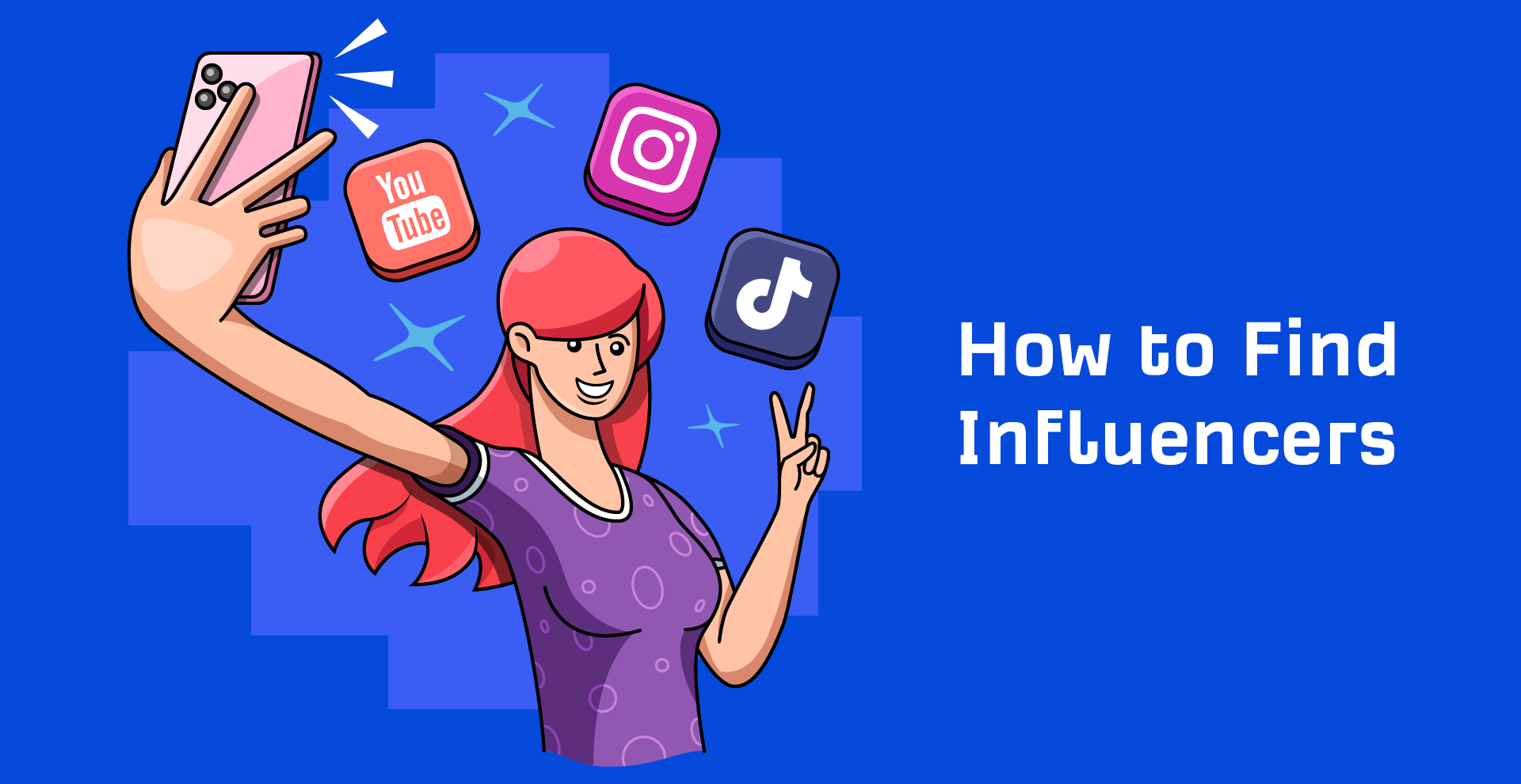SEO
6 Easy Steps to Choose the Right Ones

To help you, we’ve mapped out six steps you can follow to find the right influencers.
But before that, let’s understand whom you’d describe as the “right” one for your brand and why it’s so important.
Simply put, the right influencer is one whose followers are:
- Authentic.
- Relevant to your brand and consistently resonate with the content produced (including sponsored posts).
While it’s easy to get carried away with an influencer’s audience size, it’s important to analyze followers further to check whether they’re a right fit for your brand or not.
Failing to collaborate with the right influencer can end up burning money and hurting your brand’s reputation. Remember, today’s influencers are considered brand ambassadors.
Whether you’re looking for influencers for your very first campaign or have been through the process multiple times, it’s recommended that you don’t avoid any step. Below are six easy steps you can follow to find the right influencers.
1. Define the campaign objective and goals
The objective behind your influencer marketing campaigns and the goals you want to achieve determine which influencers and channels you should go after. Hence, it’s important to define them before starting your research.
Today, brands run influencer marketing campaigns for new product launches, promoting a sale, brand-building, and more. The goals also vary—from getting more app installs, to website visits, to impressions, to lead generation.
For example, for promoting a Christmas sale, you’ll look for Instagram influencers who promote different products on their stories, hence driving instant traffic. Remember, these goals will also help you evaluate the performance of your marketing campaign after you run it.
2. Figure out your budget
The next step is to allocate a budget for your campaign. Your budget depends on various factors, including the:
- Type of influencer (mega, micro, macro, etc.) you’re collaborating with.
- Number of influencers.
- Niche.
- Platforms you’re targeting.
- Etc.
While there’s no one way to figure out the budget, you can calculate potential conversions from your campaign and accordingly allocate the budget. But this solely depends on your goal. Sometimes, brands run influencer marketing campaigns solely for brand awareness; for this, calculating ROI can be difficult.
In some cases, brands run influencer marketing campaigns to get a better ROI (when compared to paid advertisements). So you can keep that as a benchmark when calculating the budget too.
Type of influencers
The easiest way to group influencers is on the basis of their audience size. Knowing the different groups will help you plan your strategy better. Here’s the breakdown:

3. Look for influencers
A. Look for people who’ve written about your topic
A quick way to find influencers is by creating a list of people who actively produce good content in your niche. Just a few searches on Google and YouTube can help you discover popular content pieces and their authors.
However, a simpler way of finding authors is by using Ahrefs’ Content Explorer, a searchable database of ~11 billion pages. Here are steps you can follow:
1. Open the tool and search for your topic
2. Switch the search mode from “Everywhere” to “In title” for the most relevant results and then hit “search”

3. Click the “Authors” tab to see a list of top authors and the number of content pieces they authored

You can also export the list and further filter the list to find relevant influencers according to your criterion. For example, you can filter authors who have more than 10K Twitter followers.
B. Search through popular platforms
If you’re looking for influencers in a particular niche, there’s no better way than to go through the platform itself and search for relevant topics and hashtags. In addition, you can also try the below tools and strategies.
Social Blade (for YouTube)
Social Blade is a platform that tracks statistics and analytics for YouTube channels. You can easily use it to find the top YouTubers in your niche and across different regions. It also helps you narrow your search by searching your topic as a tag.
The lists of channels can be further sorted by Social Blade rank (its own influencer score), subscriber count, and video views. Social Blade’s paid tier starts at $40/per year.

Followerwonk (for Twitter)
Followerwonk is a lightweight search engine for Twitter accounts. Just drop a keyword into the search bar to find profiles matching your desired follower count, tweet frequency, account age, and “Social Authority,” which is Followerwonk’s own influencer clout score.
Followerwonk’s free tier covers 50 searches daily, which should be enough for most people. For unlimited results, upgrades go for $29–$79/month.

Search for sponsored hashtags (for Instagram)
One quick way to find Instagram influencers is by searching for sponsored hashtags of successful sponsored campaigns in your niche. Oftentimes, brands use a unique hashtag for all posts as part of a campaign.
trendHERO (for Instagram)
If you’re looking for a platform that helps you find, analyze, and outreach Instagram followers, then you need to try trendHERO.

Apart from the above features, there’s a fake follower and competitor analysis tool. trendHERO provides a 14-day free trial with the option to analyze one Instagram account (up to 10K followers) for free. Its paid plan starts from $10/month.
Social Blade (for TikTok)

Apart from YouTube, Social Blade also allows you to search for specific TikTok accounts and analyze their audience growth. You can look at metrics like monthly gained followers, daily follower growth, and more.
C. Leverage tools
Apart from the above list of tools that help you discover influencers, there are a few tools that can help you manage your influencer campaigns end to end, right from analyzing followers to outreach.
SparkToro
It’s one of the best tools to find influencers in your niche. You can get started by just entering what your audience frequently talks about. For every search, it lists down popular social accounts, podcasts, and websites the audience follows.
Unlike other tools that rank influencers on the basis of followers, SparkToro provides you an estimation of the percentage of audience in a particular niche following a certain account. See what Rand Fishkin, co-founder and CEO of SparkToro, had to say about the same.

To further analyze, you can explore the social, websites, podcasts, and YouTube tabs on the left side. When searching for social media influencers, you can remove business accounts by setting the account type to individuals only.
To help you further understand the engagement and relevance of the account, the tool gives a SparkScore to each influencer.
If you’re looking for B2B influencers, you cannot go wrong with LinkedIn. It provides multiple parameters to filter your search. For example, you can filter the influencers on the basis of their industry, language, and more.

However, you may need an additional layer of filtering after exporting data from LinkedIn.
Heepsy
Heepsy is a platform that allows you to find, analyze, and organize Instagram, YouTube, TikTok, and Twitch influencers. It has a database of over 11 million influencers.
It’s one of the few tools in the market that can help analyze your audience and aid in outreach too. If you’re looking to scale up your influencer marketing, you should definitely explore Heepsy.
Klear

Klear allows you to manage your influencer marketing campaigns under one roof. It not only helps you discover, analyze, and manage influencers but also communicate with and measure the impact of your influencer marketing campaigns.
4. Reverse competitor backlink research
Most influencers link back to a common URL when promoting the product/brand from their content.
For example, Skillshare, which is a popular sponsor among YouTubers, has 3,000 backlinks to its sign-up page. Just by analyzing these backlinks, you can discover potential influencers.
You can easily accomplish this using Ahrefs’ Site Explorer. Here are the steps you can follow:
- Go to Site Explorer and enter the common URL on the search box with “Exact URL” selected
- Click on “Backlinks” to look at all the backlinks
- You can choose additional filters like DR and type of backlink (nofollow or dofollow) to further narrow your search

Most of the time, influencers link to the sign-up page or the homepage. You can also set up alerts on new backlinks using Ahrefs Alerts.
5. Look for brand ambassadors proactively
A lot of the time, collaborating with brand ambassadors can have a larger impact than influencers. Unlike influencers who’ve never used your product/service before, brand ambassadors already understand the value of your product/service. Hence, they can go above and beyond when promoting it.
While discovering brand ambassadors may not be hard, as they’ll eventually reach you through email or social media, we recommend finding them proactively through the following popular methods:
1. Monitor social media for people who’ve given a shout-out to your product/service or sent you a message – To automate this process, you can leverage social media monitoring tools such as Mention.
2. Keep an eye out for reviews or mentions in the form of an article or a YouTube video – To automate the process, you can set up an alert for web mentions on Ahrefs. Just set up a new alert for mentions by adding relevant keywords and choosing how often you want to receive these updates.

3. Keep an eye on newsletter mentions in your niche – The most effective way to do this is to subscribe to all the popular newsletters.
Generally, a good practice is to keep a record of your brand ambassadors so you can reach out to them when you plan to run a new campaign.
6. Get recommendations from your audience
Sometimes, finding influencers can be as easy as putting out a social media post or email to your subscribers and asking them which influencers you should partner with.
I know this sounds too good to be true, but Ahrefs did exactly that on Twitter and was overwhelmed with responses.
Not only did it find influencers quickly, but its tweet also went viral and got hundreds of responses.
We’ll be reallocating our paid traffic budget (~$200k💰) for December away from the Google/Facebook—and into sponsoring the industry’s best creators and thought leaders.
— Ahrefs (@ahrefs) November 24, 2021
Remember, when writing the post, you need to provide enough information to your readers so that you only get relevant suggestions. For example, Ahrefs mentioned the following in the post:
- Budget
- Type of influencers
- Channels
Also, remember to ask your readers to amplify your tweet to increase your reach.
After building your influencer list, don’t start your outreach instantly. I recommend going through an extensive vetting process. This is because the last thing you want your campaigns to reach is fake followers.
During the vetting process, you should look at metrics like:
- Engagement rate – This number denotes the level of engagement generated from a piece of content. You can calculate this at a post level or an account level. For example, the average engagement rate on Instagram is 0.98% (Sprout Social).

- Engagement quality – This is the percentage of real/active followers among the total engaged followers. While finding this manually is difficult, multiple tools can help you find the engagement quality for a certain account.
- Growth rate – This shows the number of subscribers added by an influencer in a certain period of time. Social Blade, for example, shows the growth rate for an influencer both daily and monthly.
A lot of the tools we’ve covered above can easily help you find the above metrics. However, you can also find these metrics manually by going through the profiles. Sometimes, just a glance is enough to differentiate an authentic influencer from a fake one.
Also, remember the niche also has an impact on the engagement rate and growth. Hence, compare influencers and their engagement rate/quality only within the same niche.
Before reaching out to influencers, you should also look at the sponsorships they’ve done before and if your brand values align with theirs. If they don’t, you’re better off not collaborating with those influencers.
In a digital world, everything you publish online is reflective of your brand. One small mistake is enough to create outrage and tarnish your brand. This holds true for whom you collaborate with too. Hence, it’s important to take enough time to analyze influencers before collaborating with them.
Final thoughts
If you want to run successful influencer marketing campaigns, you need to look beyond relevancy and follower count.
Even when you have the budget to collaborate with a mega influencer, you can get a better result by collaborating with multiple micro influencers.
Hope our guide helps you find the right influencers and that it answered a few questions you had before reading this article.
Got more questions? Ping me on Twitter.
SEO
How to Revive an Old Blog Article for SEO

Quick question: What do you typically do with your old blog posts? Most likely, the answer is: Not much.
If that’s the case, you’re not alone. Many of us in SEO and content marketing tend to focus on continuously creating new content, rather than leveraging our existing blog posts.
However, here’s the reality—Google is becoming increasingly sophisticated in evaluating content quality, and we need to adapt accordingly. Just as it’s easier to encourage existing customers to make repeat purchases, updating old content on your website is a more efficient and sustainable strategy in the long run.
Ways to Optimize Older Content
Some of your old content might not be optimized for SEO very well, rank for irrelevant keywords, or drive no traffic at all. If the quality is still decent, however, you should be able to optimize it properly with little effort.
Refresh Content
If your blog post contains a specific year or mentions current events, it may become outdated over time. If the rest of the content is still relevant (like if it’s targeting an evergreen topic), simply updating the date might be all you need to do.
Rewrite Old Blog Posts
When the content quality is low (you might have greatly improved your writing skills since you’ve written the post) but the potential is still there, there’s not much you can do apart from rewriting an old blog post completely.
This is not a waste—you’re saving time on brainstorming since the basic structure is already in place. Now, focus on improving the quality.
Delete Old Blog Posts
You might find a blog post that just seems unusable. Should you delete your old content? It depends. If it’s completely outdated, of low quality, and irrelevant to any valuable keywords for your website, it’s better to remove it.
Once you decide to delete the post, don’t forget to set up a 301 redirect to a related post or page, or to your homepage.
Promote Old Blog Posts
Sometimes all your content needs is a bit of promotion to start ranking and getting traffic again. Share it on your social media, link to it from a new post – do something to get it discoverable again to your audience. This can give it the boost it needs to attract organic links too.
Which Blog Posts Should You Update?
Deciding when to update or rewrite blog posts is a decision that relies on one important thing: a content audit.
Use your Google Analytics to find out which blog posts used to drive tons of traffic, but no longer have the same reach. You can also use Google Search Console to find out which of your blog posts have lost visibility in comparison to previous months. I have a guide on website analysis using Google Analytics and Google Search Console you can follow.
If you use keyword tracking tools like SE Ranking, you can also use the data it provides to come up with a list of blog posts that have dropped in the rankings.
Make data-driven decisions to identify which blog posts would benefit from these updates – i.e., which ones still have the chance to recover their keyword rankings and organic traffic.
With Google’s helpful content update, which emphasizes better user experiences, it’s crucial to ensure your content remains relevant, valuable, and up-to-date.
How To Update Old Blog Posts for SEO
Updating articles can be an involved process. Here are some tips and tactics to help you get it right.
Author’s Note: I have a Comprehensive On-Page SEO Checklist you might also be interested in following while you’re doing your content audit.
Conduct New Keyword Research
Updating your post without any guide won’t get you far. Always do your keyword research to understand how users are searching for your given topic.
Proper research can also show you relevant questions and sections that can be added to the blog post you’re updating or rewriting. Make sure to take a look at the People Also Ask (PAA) section that shows up when you search for your target keyword. Check out other websites like Answer The Public, Reddit, and Quora to see what users are looking for too.
Look for New Ranking Opportunities
When trying to revive an old blog post for SEO, keep an eye out for new SEO opportunities (e.g., AI Overview, featured snippets, and related search terms) that didn’t exist when you first wrote your blog post. Some of these features can be targeted by the new content you will add to your post, if you write with the aim to be eligible for it.
Rewrite Headlines and Meta Tags
If you want to attract new readers, consider updating your headlines and meta tags.
Your headlines and meta tags should fulfill these three things:
- Reflect the rewritten and new content you’ve added to the blog post.
- Be optimized for the new keywords it’s targeting (if any).
- Appeal to your target audience – who may have changed tastes from when the blog post was originally made.
Remember that your meta tags in particular act like a brief advertisement for your blog post, since this is what the user first sees when your blog post is shown in the search results page.
Take a look at your blog post’s click-through rate on Google Search Console – if it falls below 2%, it’s definitely time for new meta tags.
Replace Outdated Information and Statistics
Updating blog content with current studies and statistics enhances the relevance and credibility of your post. By providing up-to-date information, you help your audience make better, well-informed decisions, while also showing that your content is trustworthy.
Tighten or Expand Ideas
Your old content might be too short to provide real value to users – or you might have rambled on and on in your post. It’s important to evaluate whether you need to make your content more concise, or if you need to elaborate more.
Keep the following tips in mind as you refine your blog post’s ideas:
- Evaluate Helpfulness: Measure how well your content addresses your readers’ pain points. Aim to follow the E-E-A-T model (Experience, Expertise, Authoritativeness, Trustworthiness).
- Identify Missing Context: Consider whether your content needs more detail or clarification. View it from your audience’s perspective and ask if the information is complete, or if more information is needed.
- Interview Experts: Speak with industry experts or thought leaders to get fresh insights. This will help support your writing, and provide unique points that enhance the value of your content.
- Use Better Examples: Examples help simplify complex concepts. Add new examples or improve existing ones to strengthen your points.
- Add New Sections if Needed: If your content lacks depth or misses a key point, add new sections to cover these areas more thoroughly.
- Remove Fluff: Every sentence should contribute to the overall narrative. Eliminate unnecessary content to make your post more concise.
- Revise Listicles: Update listicle items based on SEO recommendations and content quality. Add or remove headings to stay competitive with higher-ranking posts.
Improve Visuals and Other Media
No doubt that there are tons of old graphics and photos in your blog posts that can be improved with the tools we have today. Make sure all of the visuals used in your content are appealing and high quality.
Update Internal and External Links
Are your internal and external links up to date? They need to be for your SEO and user experience. Outdated links can lead to broken pages or irrelevant content, frustrating readers and hurting your site’s performance.
You need to check for any broken links on your old blog posts, and update them ASAP. Updating your old blog posts can also lead to new opportunities to link internally to other blog posts and pages, which may not have been available when the post was originally published.
Optimize for Conversions
When updating content, the ultimate goal is often to increase conversions. However, your conversion goals may have changed over the years.
So here’s what you need to check in your updated blog post. First, does the call-to-action (CTA) still link to the products or services you want to promote? If not, update it to direct readers to the current solution or offer.
Second, consider where you can use different conversion strategies. Don’t just add a CTA at the end of the post.
Last, make sure that the blog post leverages product-led content. It’s going to help you mention your products and services in a way that feels natural, without being too pushy. Being subtle can be a high ROI tactic for updated posts.
Key Takeaway
Reviving old blog articles for SEO is a powerful strategy that can breathe new life into your content and boost your website’s visibility. Instead of solely focusing on creating new posts, taking the time to refresh existing content can yield impressive results, both in terms of traffic and conversions.
By implementing these strategies, you can transform old blog posts into valuable resources that attract new readers and retain existing ones. So, roll up your sleeves, dive into your archives, and start updating your content today—your audience and search rankings will thank you!
SEO
How Compression Can Be Used To Detect Low Quality Pages

The concept of Compressibility as a quality signal is not widely known, but SEOs should be aware of it. Search engines can use web page compressibility to identify duplicate pages, doorway pages with similar content, and pages with repetitive keywords, making it useful knowledge for SEO.
Although the following research paper demonstrates a successful use of on-page features for detecting spam, the deliberate lack of transparency by search engines makes it difficult to say with certainty if search engines are applying this or similar techniques.
What Is Compressibility?
In computing, compressibility refers to how much a file (data) can be reduced in size while retaining essential information, typically to maximize storage space or to allow more data to be transmitted over the Internet.
TL/DR Of Compression
Compression replaces repeated words and phrases with shorter references, reducing the file size by significant margins. Search engines typically compress indexed web pages to maximize storage space, reduce bandwidth, and improve retrieval speed, among other reasons.
This is a simplified explanation of how compression works:
- Identify Patterns:
A compression algorithm scans the text to find repeated words, patterns and phrases - Shorter Codes Take Up Less Space:
The codes and symbols use less storage space then the original words and phrases, which results in a smaller file size. - Shorter References Use Less Bits:
The “code” that essentially symbolizes the replaced words and phrases uses less data than the originals.
A bonus effect of using compression is that it can also be used to identify duplicate pages, doorway pages with similar content, and pages with repetitive keywords.
Research Paper About Detecting Spam
This research paper is significant because it was authored by distinguished computer scientists known for breakthroughs in AI, distributed computing, information retrieval, and other fields.
Marc Najork
One of the co-authors of the research paper is Marc Najork, a prominent research scientist who currently holds the title of Distinguished Research Scientist at Google DeepMind. He’s a co-author of the papers for TW-BERT, has contributed research for increasing the accuracy of using implicit user feedback like clicks, and worked on creating improved AI-based information retrieval (DSI++: Updating Transformer Memory with New Documents), among many other major breakthroughs in information retrieval.
Dennis Fetterly
Another of the co-authors is Dennis Fetterly, currently a software engineer at Google. He is listed as a co-inventor in a patent for a ranking algorithm that uses links, and is known for his research in distributed computing and information retrieval.
Those are just two of the distinguished researchers listed as co-authors of the 2006 Microsoft research paper about identifying spam through on-page content features. Among the several on-page content features the research paper analyzes is compressibility, which they discovered can be used as a classifier for indicating that a web page is spammy.
Detecting Spam Web Pages Through Content Analysis
Although the research paper was authored in 2006, its findings remain relevant to today.
Then, as now, people attempted to rank hundreds or thousands of location-based web pages that were essentially duplicate content aside from city, region, or state names. Then, as now, SEOs often created web pages for search engines by excessively repeating keywords within titles, meta descriptions, headings, internal anchor text, and within the content to improve rankings.
Section 4.6 of the research paper explains:
“Some search engines give higher weight to pages containing the query keywords several times. For example, for a given query term, a page that contains it ten times may be higher ranked than a page that contains it only once. To take advantage of such engines, some spam pages replicate their content several times in an attempt to rank higher.”
The research paper explains that search engines compress web pages and use the compressed version to reference the original web page. They note that excessive amounts of redundant words results in a higher level of compressibility. So they set about testing if there’s a correlation between a high level of compressibility and spam.
They write:
“Our approach in this section to locating redundant content within a page is to compress the page; to save space and disk time, search engines often compress web pages after indexing them, but before adding them to a page cache.
…We measure the redundancy of web pages by the compression ratio, the size of the uncompressed page divided by the size of the compressed page. We used GZIP …to compress pages, a fast and effective compression algorithm.”
High Compressibility Correlates To Spam
The results of the research showed that web pages with at least a compression ratio of 4.0 tended to be low quality web pages, spam. However, the highest rates of compressibility became less consistent because there were fewer data points, making it harder to interpret.
Figure 9: Prevalence of spam relative to compressibility of page.
The researchers concluded:
“70% of all sampled pages with a compression ratio of at least 4.0 were judged to be spam.”
But they also discovered that using the compression ratio by itself still resulted in false positives, where non-spam pages were incorrectly identified as spam:
“The compression ratio heuristic described in Section 4.6 fared best, correctly identifying 660 (27.9%) of the spam pages in our collection, while misidentifying 2, 068 (12.0%) of all judged pages.
Using all of the aforementioned features, the classification accuracy after the ten-fold cross validation process is encouraging:
95.4% of our judged pages were classified correctly, while 4.6% were classified incorrectly.
More specifically, for the spam class 1, 940 out of the 2, 364 pages, were classified correctly. For the non-spam class, 14, 440 out of the 14,804 pages were classified correctly. Consequently, 788 pages were classified incorrectly.”
The next section describes an interesting discovery about how to increase the accuracy of using on-page signals for identifying spam.
Insight Into Quality Rankings
The research paper examined multiple on-page signals, including compressibility. They discovered that each individual signal (classifier) was able to find some spam but that relying on any one signal on its own resulted in flagging non-spam pages for spam, which are commonly referred to as false positive.
The researchers made an important discovery that everyone interested in SEO should know, which is that using multiple classifiers increased the accuracy of detecting spam and decreased the likelihood of false positives. Just as important, the compressibility signal only identifies one kind of spam but not the full range of spam.
The takeaway is that compressibility is a good way to identify one kind of spam but there are other kinds of spam that aren’t caught with this one signal. Other kinds of spam were not caught with the compressibility signal.
This is the part that every SEO and publisher should be aware of:
“In the previous section, we presented a number of heuristics for assaying spam web pages. That is, we measured several characteristics of web pages, and found ranges of those characteristics which correlated with a page being spam. Nevertheless, when used individually, no technique uncovers most of the spam in our data set without flagging many non-spam pages as spam.
For example, considering the compression ratio heuristic described in Section 4.6, one of our most promising methods, the average probability of spam for ratios of 4.2 and higher is 72%. But only about 1.5% of all pages fall in this range. This number is far below the 13.8% of spam pages that we identified in our data set.”
So, even though compressibility was one of the better signals for identifying spam, it still was unable to uncover the full range of spam within the dataset the researchers used to test the signals.
Combining Multiple Signals
The above results indicated that individual signals of low quality are less accurate. So they tested using multiple signals. What they discovered was that combining multiple on-page signals for detecting spam resulted in a better accuracy rate with less pages misclassified as spam.
The researchers explained that they tested the use of multiple signals:
“One way of combining our heuristic methods is to view the spam detection problem as a classification problem. In this case, we want to create a classification model (or classifier) which, given a web page, will use the page’s features jointly in order to (correctly, we hope) classify it in one of two classes: spam and non-spam.”
These are their conclusions about using multiple signals:
“We have studied various aspects of content-based spam on the web using a real-world data set from the MSNSearch crawler. We have presented a number of heuristic methods for detecting content based spam. Some of our spam detection methods are more effective than others, however when used in isolation our methods may not identify all of the spam pages. For this reason, we combined our spam-detection methods to create a highly accurate C4.5 classifier. Our classifier can correctly identify 86.2% of all spam pages, while flagging very few legitimate pages as spam.”
Key Insight:
Misidentifying “very few legitimate pages as spam” was a significant breakthrough. The important insight that everyone involved with SEO should take away from this is that one signal by itself can result in false positives. Using multiple signals increases the accuracy.
What this means is that SEO tests of isolated ranking or quality signals will not yield reliable results that can be trusted for making strategy or business decisions.
Takeaways
We don’t know for certain if compressibility is used at the search engines but it’s an easy to use signal that combined with others could be used to catch simple kinds of spam like thousands of city name doorway pages with similar content. Yet even if the search engines don’t use this signal, it does show how easy it is to catch that kind of search engine manipulation and that it’s something search engines are well able to handle today.
Here are the key points of this article to keep in mind:
- Doorway pages with duplicate content is easy to catch because they compress at a higher ratio than normal web pages.
- Groups of web pages with a compression ratio above 4.0 were predominantly spam.
- Negative quality signals used by themselves to catch spam can lead to false positives.
- In this particular test, they discovered that on-page negative quality signals only catch specific types of spam.
- When used alone, the compressibility signal only catches redundancy-type spam, fails to detect other forms of spam, and leads to false positives.
- Combing quality signals improves spam detection accuracy and reduces false positives.
- Search engines today have a higher accuracy of spam detection with the use of AI like Spam Brain.
Read the research paper, which is linked from the Google Scholar page of Marc Najork:
Detecting spam web pages through content analysis
Featured Image by Shutterstock/pathdoc
SEO
New Google Trends SEO Documentation

Google Search Central published new documentation on Google Trends, explaining how to use it for search marketing. This guide serves as an easy to understand introduction for newcomers and a helpful refresher for experienced search marketers and publishers.
The new guide has six sections:
- About Google Trends
- Tutorial on monitoring trends
- How to do keyword research with the tool
- How to prioritize content with Trends data
- How to use Google Trends for competitor research
- How to use Google Trends for analyzing brand awareness and sentiment
The section about monitoring trends advises there are two kinds of rising trends, general and specific trends, which can be useful for developing content to publish on a site.
Using the Explore tool, you can leave the search box empty and view the current rising trends worldwide or use a drop down menu to focus on trends in a specific country. Users can further filter rising trends by time periods, categories and the type of search. The results show rising trends by topic and by keywords.
To search for specific trends users just need to enter the specific queries and then filter them by country, time, categories and type of search.
The section called Content Calendar describes how to use Google Trends to understand which content topics to prioritize.
Google explains:
“Google Trends can be helpful not only to get ideas on what to write, but also to prioritize when to publish it. To help you better prioritize which topics to focus on, try to find seasonal trends in the data. With that information, you can plan ahead to have high quality content available on your site a little before people are searching for it, so that when they do, your content is ready for them.”
Read the new Google Trends documentation:
Get started with Google Trends
Featured Image by Shutterstock/Luis Molinero














You must be logged in to post a comment Login